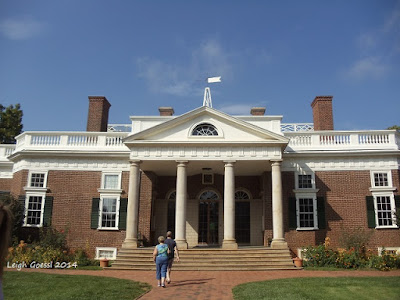Fun facts about Monticello (Charlottesville, Va.)
Along with his life in politics, the 3rd U.S.
President Thomas Jefferson was an avid reader and an architect. His
architectural print or influence is on many buildings. One of his best works is
his own home – his beloved Monticello, located in Albermarle County, Virginia.
Today the Charlottesville home is opened to the public and
maintained as a historical landmark. Charlottesville is a booming area
and with its hub being the University of Virginia (UVA), the college Jefferson
founded. Run by the Thomas Jefferson Foundation (founded in 1923), Monticello is preserved as it would have looked like in
Jefferson’s day.
10 Fun Facts About Monticello
1. Thomas Jefferson
began work on Monticello in 1769, but took many years to finish. The home was a
work in progress for more than 40 years. He referred to Monticello as “his essay in architecture” Monticello would evolve during the decades of its build and take on
many different styles. The home became habitable in 1772, but wouldn’t be
completed to his satisfaction until 1808.
 |
| Front entrance of Monticello |
2. Originally, Jefferson designed Monticello to have 14
rooms, but in the end had more than 40.
3. Throughout his life, Jefferson was highly interested in
westward expansion, Native American life, exploration and technology. As a
result, these interests were reflected this in how he chose to decorate his
home. Many original pieces are still on display.
4. Monticello means “little mountain”.
5. Jefferson was
meticulous in his record keeping. Due to this, over the years efforts to get
the house back to the way it Jefferson had it is pretty accurate. Touring the
home, you can see many original pieces.
6. Monticello has a wine dumbwaiter that is still visible
today.
7. Jefferson was also a farmer and loved to use the latest
research and technology to try out new approaches to farming. Over the years he
planted more than 1,000 fruit trees (170 fruit varieties) and his garden
contained 330 vegetable varieties. He also had a vineyard and plant nursery.
8. “Mulberry Row” was the center of the plantation. Over time,
17 structures came together to form the 1,000-foot-long
Mulberry Row. It included about 20 dwellings for free whites, free blacks,
indentured servants and enslaved people. Work areas included ironworking,
tinning, spinning and weaving, wine cellars, a stable and more.
9. The pond, which is located a short distance from the main
house, looks to be ornamental, but like everything else, it actually served a
function. Fresh fish that was caught for meals were stored in the pond.
10. The personal library adjacent to Jefferson’s bedroom no
longer houses his original books. Most are reproductions of what he did
actually own. After the U.S. Capitol was burned during the War of 1812 (which
then housed the Library of Congress), Jefferson sold his vast collection, totaling 6,487, to the U.S. government. Most of
those books survived (unfortunately, a second Capitol fire in 1851 destroyed
some of those), but what survived can still be viewed today in Washington, D.C.
Jefferson lived out his private life at Monticello and died on July 4, 1826, 50 years to the day America celebrates the signing of the Declaration of Independence, the document he had penned. He is buried in Monticello's family cemetery located on the property.
[ Related reading: 10 fun facts about the Library of Congress ]
Jefferson lived out his private life at Monticello and died on July 4, 1826, 50 years to the day America celebrates the signing of the Declaration of Independence, the document he had penned. He is buried in Monticello's family cemetery located on the property.





Comments
Post a Comment